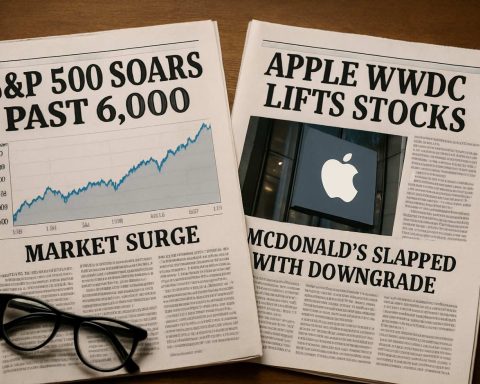- Tesla aims to become a tech giant, expanding beyond electric vehicles into autonomous driving and robotics.
- The potential Cybercab service and Optimus robot signal a diversification of Tesla’s business model.
- Stock values have risen, driven by innovation and supportive political alliances.
- Tesla still primarily relies on traditional vehicle sales, facing its first production decline in 2024.
- The company’s high stock valuation raises questions about its financial transparency.
- Competition in AI, robotics, and sustainable technology is expected to intensify.
- Tesla’s dual role as an automaker and tech innovator could significantly impact future industries.
Tesla is on the brink of a seismic shift, poised to transcend its identity as solely an electric vehicle (EV) manufacturer and step boldly into the tech giant arena. Witnessing an astonishing rise in stock values, Tesla is capturing the market’s imagination with its groundbreaking advancements in autonomous driving and robotics. This shift hints at a future where Tesla could redefine its business model, thanks to prospective innovations like the Cybercab—a visionary autonomous ride-hailing service—and the multifaceted Optimus robot.
The market’s response has been enthusiastic, buoyed by emerging political alliances that may simplify the path for Tesla’s trailblazing services. Yet, amidst the excitement, it’s essential to recognize that Tesla still derives most of its revenue from traditional vehicle sales—a sector that recently saw its first production decline in 2024.
Financial clarity remains elusive, as Tesla’s current stock price is more than 15 times its sales, sparking debate over its valuation. For potential investors, the lure of Tesla’s cutting-edge projects must be balanced against its high stock valuation and reliance on conventional vehicle sales.
Several trends loom on the horizon: intensified competition as other tech and auto giants venture into Tesla’s domain, further advancements in AI and robotics, and a global push towards sustainability. Tesla’s foray into autonomous services and robotics not only envisions urban transport transformation but also addresses future workforce dynamics.
In a world striving for cleaner, smarter technology, Tesla sits at a pivotal crossroads, poised to influence industries far beyond automotive. For investors and industry watchers alike, the journey ahead calls for both enthusiasm and discernment as the company balances its dual identity as an automaker and an aspiring tech leader.
The Future of Tesla: From EV Manufacturer to Tech Powerhouse
Tesla is not just about electric vehicles anymore. As it hovers on the brink of becoming a tech giant, Tesla’s ambitions are far-reaching, with breakthroughs in autonomous driving and robotics already in motion. However, as Tesla charts this new course, critical questions arise about its market position and future innovations.
Key Questions and Answers
1. What are the primary innovations driving Tesla’s transformation beyond automotive?
Tesla is pioneering several cutting-edge innovations that extend its influence beyond traditional automotive manufacturing:
– Autonomous Driving Technologies: Tesla is investing heavily in its Full Self-Driving (FSD) capabilities, positioning itself as a leader in industry safety standards and autonomy.
– Robotics: With the development of Optimus, Tesla aims to integrate robotics into daily life, potentially addressing labor shortages and transforming service industries.
– Cybercab Service: This proposed autonomous ride-hailing service could redefine urban transportation, offering efficient and sustainable mobility solutions.
These innovations suggest Tesla’s future may more closely resemble that of a tech firm than a conventional car company.
2. How does Tesla’s current business model sustain its ambitions, given its high stock valuation and reliance on vehicle sales?
Despite its forward-thinking initiatives, Tesla faces significant financial scrutiny:
– Tesla’s valuation exceeds 15 times its sales, warranting a focus on future profitability and revenue diversification.
– The decline in traditional vehicle production in 2024 signals a need for increased reliance on innovative products like FSD and Optimus.
– Strategic iterations and new partnerships may bolster Tesla’s market positioning, proving instrumental in transitioning towards a more tech-oriented revenue stream.
As Tesla grapples with these financial dynamics, its strategy must align its ambitious R&D investments with viable revenue prospects.
3. What role do political alliances and market trends play in Tesla’s evolving landscape?
Political and market forces are instrumental in shaping Tesla’s future:
– Political Alliances: Emerging policies are increasingly favorable for electric and autonomous vehicles, potentially easing Tesla’s market entry and operational expansion.
– Market Trends: Global demand for sustainability in transport and technology compels Tesla to innovate within its core values of safety, efficiency, and environmental responsibility.
– Competition: Other tech giants like Google and automotive leaders like BMW are intensifying competition, pushing Tesla to maintain its innovation edge.
These elements underscore the complex interplay of socio-political factors that will impact Tesla’s strategic decisions and industry influence.
Industry Links
– For more insights on Tesla’s mission and projects, visit the official Tesla website.
– To explore alternatives and industry trends, check out resources at BWM or Google.
Conclusion
Tesla stands at a transformative moment, bridging its automotive roots with a future of expansive tech innovations. As the company unfolds its dual identity, stakeholders face a journey grounded in both enthusiasm for technology and caution around financial sustainability. The coming years promise both risk and reward as Tesla strives to redefine its place in a rapidly evolving global market.











